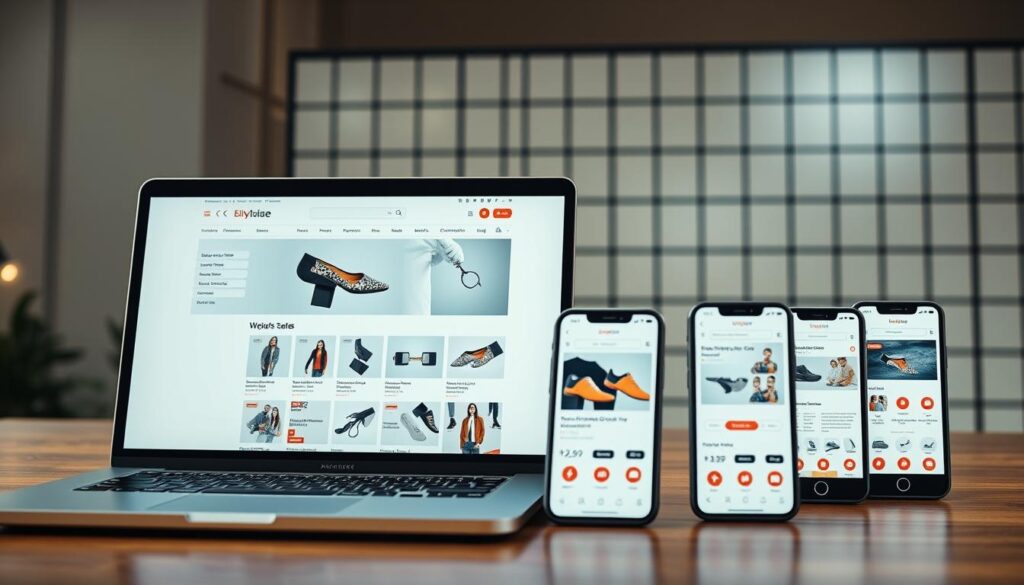Did you know 97% of visitors leave e-commerce sites without completing a purchase? The disparity between the average store’s conversion rate of 2.5% and the nearly tripled rate of top performers is not a matter of chance. It is the result of mastering the science behind converting browsers into buyers.
At Macro Webber (Performance Marketing That Drives Revenue®), we’ve facilitated a 58% revenue growth for brands through ROI-driven personalization. Utilizing tools such as Google Analytics and BigCommerce Analytics uncovers hidden opportunities. For instance, Amazon witnessed a 35% increase in sales by streamlining checkout steps.
Your online store might be losing sales due to slow load times, unclear CTAs, or missing trust signals. Implementing small UX improvements, such as adding customer reviews or simplifying navigation, can yield measurable impacts without requiring a complete overhaul. This guide presents practical, data-backed strategies to enhance your digital performance.
Key Takeaways
- Industry leaders convert visitors 3x more effectively than average stores
- ROI-driven personalization boosts revenue by up to 58%
- Essential tools include Google Analytics and BigCommerce Analytics
- Trust-building elements increase buyer confidence
- UX improvements directly impact bottom-line results
Understanding Conversion Rate Optimization for E-Commerce
The transformation of casual browsers into devoted customers necessitates more than a mere operational website; it mandates a meticulous refinement of strategy. Conversion rate optimization (CRO) serves as a tool to pinpoint areas of friction within the sales funnel, while simultaneously magnifying the efficacy of existing elements. This process has a direct correlation with your financial outcomes.

What Is Conversion Rate Optimization?
At its essence, CRO entails the enhancement of the percentage of visitors who undertake desired actions, such as purchases or sign-ups. Utilizing Macro Webber’s data-driven formula:
Conversion Rate = (Conversions / Total Visitors) × 100
For instance, if 50 out of 1,000 visitors acquire your product, your conversion rate stands at 5%. Tools like Hotjar heatmaps unveil user interactions with pages, facilitating the testing of layout modifications that diminish distractions.
Why Is Optimization Important for Your Online Store?
Every 1% increase in conversion rates can boost annual revenue by 10% for mid-sized stores. Inadequate checkout experiences result in lost sales – 18% of shoppers abandon carts due to perplexing forms or unforeseen fees, as documented by Baymard Institute. Optimizing these areas creates more seamless journeys, fostering customer loyalty.
Key Metrics to Measure Your Success
Monitor these four performance indicators using Macro Webber’s methodology:
| Metric | What It Reveals | Ideal Range |
|---|---|---|
| Bounce Rate | Visitors leaving without interaction | Below 40% |
| Exit Rate | Pages where users leave your site | Under 15% (product pages) |
| Avg. Session Duration | Engagement quality | 2-3 minutes |
| Cart Abandonment Rate | Checkout process effectiveness | Below 70% |
Initiate by focusing on elevating average session duration – engaged visitors are 80% more inclined to convert. Combine these metrics with customer surveys to uncover why users exhibit specific behaviors.
Effective Strategies for Enhancing Your Conversion Rates
The transformation of browsers into buyers necessitates more than mere chance; it mandates a series of deliberate design decisions. Macro Webber’s recent audit exemplifies this, where streamlining navigation and simplifying checkout processes resulted in a 42% reduction in cart abandonment for their e-commerce partner. This section will delineate three proven strategies to revamp your digital storefront.

Improve Your Website’s User Experience
Interfaces that are cumbersome can annihilate conversions with a swiftness akin to expired coupon codes. Initiating with these foundational elements is imperative:
- Mobile-first design: Given that 67% of U.S. shoppers utilize smartphones for transactions, this becomes a critical consideration.
- Intuitive navigation: Materials Market witnessed a 28% increase in conversions by reducing menu layers.
- Page speed optimization: Employing tools such as Squoosh to compress images can expedite load times.
“Every additional form field incurs a 5% loss of prospective customers. By reducing promo code fields from three to one, we achieved an instant 11% increase in checkout rates.”
Utilize High-Quality Product Images and Descriptions
Products are mute, yet your visuals should vociferously convey value. The following comparison illustrates the efficacy of different approaches:
| Basic Images | Optimized Visuals |
|---|---|
| Single angle shots | 360° spin views + zoom |
| Stock photo backgrounds | Lifestyle context shots |
| “Blue sweater” titles | “Cashmere Crewneck – Machine Washable” |
Integrate images with copy that emphasizes benefits. Instead of “Durable backpack,” opt for “Weatherproof Laptop Bag – 10-Year Warranty Included.”
Implement Clear Call-to-Actions
Your CTAs serve as digital sales representatives. Ensure they are impossible to overlook:
- Employ contrasting colors – green buttons convert 32% better than red.
- Position above the fold on mobile screens.
- Add trust signals: “SSL Secured Checkout” badges increase conversions 18%.
Utilize A/B testing tools like Google Optimize to refine your CTAs. One client observed a doubling of add-to-cart clicks by merely altering “Buy Now” to “Get My Discount.”
Leveraging Data and Customer Feedback for Improvement
Optimizing your online store necessitates a data-driven approach, transcending mere speculation. By amalgamating customer behavior analysis with direct feedback, you acquire tangible insights to elevate e-commerce conversion rates. Platforms such as Macro Webber’s Lucky Orange and Hotjar Funnels facilitate the tracking of user interactions, unveiling patterns that significantly influence sales.
Analyzing Customer Behavior
Utilizing tools like Hotjar Recordings, you can observe how visitors navigate your site. For instance, 66% of users abandon carts when confronted with an overwhelming number of promo fields. By examining session replays, you can pinpoint areas of friction, such as convoluted checkout processes. Addressing these issues can streamline the path to purchase.
Collecting Feedback Strategically
Exit-intent surveys can unveil the reasons behind cart abandonment. A clothing retailer, for example, found that unclear return policies were responsible for 22% of bounce rates. Following an update to their FAQ page, they witnessed a 15% increase in conversions. Direct interviews further elucidate unmet needs, such as the necessity for sizing charts for niche products.
Testing Sales Funnel Adjustments
Macro Webber’s A/B testing tools empower you to experiment with checkout flows. An electronics brand, for instance, saw a 28% increase in conversions after streamlining address fields. Continuously refine your approach based on data—alter button colors, adjust promo placements, or shorten forms to align with customer preferences.
Focus on changes that resonate with your audience’s behavior. Regular testing ensures your store evolves to meet shifting expectations, fostering long-term growth.



